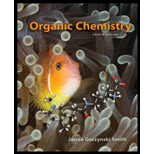
Concept explainers
(a)
Interpretation:
To explain how the given molecules behaves like a soap and cleans away dirt.
Concept introduction:
Solubility is the extent to which a compound (the solute) dissolves in a liquid (the solvent). In dissolving a compound in a liquid, the energy needs to break up the interactions between the molecules or ions of the solute comes from new interactions between the solute and the solvent. The concept involved in the solubility are
a. "Like dissolves like."
b. Polar compounds dissolve in polar solvents. Nonpolar or weakly polar compounds dissolve in nonpolar or weakly polar solvents.
(b)
Interpretation:
To explain how the given molecules behaves like a soap and cleans away dirt.
Concept introduction:
Solubility is the extent to which a compound (the solute) dissolves in a liquid (the solvent). In dissolving a compound in a liquid, the energy needs to break up the interactions between the molecules or ions of the solute comes from new interactions between the solute and the solvent. The concept involved in the solubility are
a. "Like dissolves like."
b. Polar compounds dissolve in polar solvents. Nonpolar or weakly polar compounds dissolve in nonpolar or weakly polar solvents.
Want to see the full answer?
Check out a sample textbook solution
Chapter 3 Solutions
Package: Organic Chemistry With Connect 2-semester Access Card
- Are acids and bases used in everyday life? Name some acids and bases from your everyday life and why they are important. If you're stuck look at some ingredients of the following: Juices, carbonated water, cleaners, soap, shampoo, preservatives baking soda.arrow_forwardWhat is an alkaloid? Explain by giving an examplearrow_forwardAnswer the question in full and detailed sentences/paragraphs and use diagrams to explain your answer.arrow_forward
 Introductory Chemistry: A FoundationChemistryISBN:9781337399425Author:Steven S. Zumdahl, Donald J. DeCostePublisher:Cengage LearningChemistry: Matter and ChangeChemistryISBN:9780078746376Author:Dinah Zike, Laurel Dingrando, Nicholas Hainen, Cheryl WistromPublisher:Glencoe/McGraw-Hill School Pub Co
Introductory Chemistry: A FoundationChemistryISBN:9781337399425Author:Steven S. Zumdahl, Donald J. DeCostePublisher:Cengage LearningChemistry: Matter and ChangeChemistryISBN:9780078746376Author:Dinah Zike, Laurel Dingrando, Nicholas Hainen, Cheryl WistromPublisher:Glencoe/McGraw-Hill School Pub Co Chemistry & Chemical ReactivityChemistryISBN:9781337399074Author:John C. Kotz, Paul M. Treichel, John Townsend, David TreichelPublisher:Cengage Learning
Chemistry & Chemical ReactivityChemistryISBN:9781337399074Author:John C. Kotz, Paul M. Treichel, John Townsend, David TreichelPublisher:Cengage Learning World of Chemistry, 3rd editionChemistryISBN:9781133109655Author:Steven S. Zumdahl, Susan L. Zumdahl, Donald J. DeCostePublisher:Brooks / Cole / Cengage Learning
World of Chemistry, 3rd editionChemistryISBN:9781133109655Author:Steven S. Zumdahl, Susan L. Zumdahl, Donald J. DeCostePublisher:Brooks / Cole / Cengage Learning Chemistry: The Molecular ScienceChemistryISBN:9781285199047Author:John W. Moore, Conrad L. StanitskiPublisher:Cengage Learning
Chemistry: The Molecular ScienceChemistryISBN:9781285199047Author:John W. Moore, Conrad L. StanitskiPublisher:Cengage Learning




